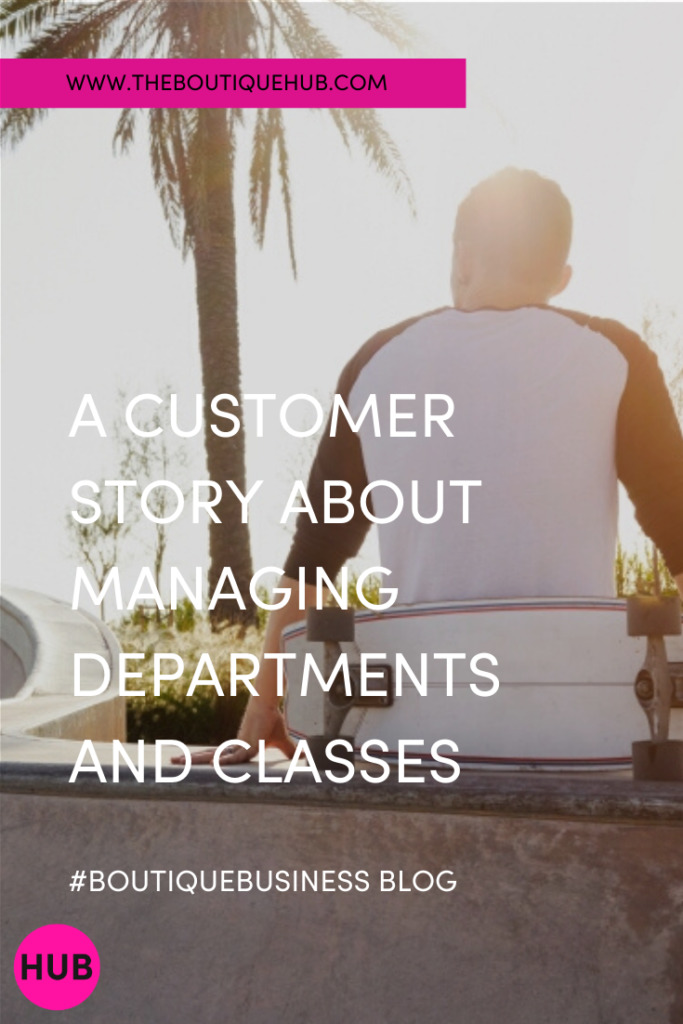Managing your store without a POS system in place is a difficult thing to do. Part of any good POS system is its ability to structure your inventory into departments and classes. RetailEdge POS Software allows you to break up your store into smaller segments by departments. This will allow you to respond faster to the market and as a result, be able to buy smarter. Since most POS systems have some sort of department structure in place you have probably already created these. Here are a couple of things to consider. As your store has grown, have you changed your departments to keep up with the changes? Are you getting the best possible information from the current structure?
A Customer Story about managing Departments & Classes

About ten years ago I opened up a skateboard shop. In that shop, I had men’s clothing, shoes, and skateboards as departments. I kept it simple. Now at the time, I did not think anything of the way I structured the department hierarchy. It was in line with the product I sold. All men’s clothing went into the men’s clothing department. As I was looking at a sales report, I tried to figure out what was selling and what was not. Because of how I had originally set up the departments it was difficult. I would have to look at every item and see what their performance was. This was going to be a nightmare to perform and pretty time-consuming.
Using POS Classes to Refine your Sales Analysis
Now, if I only knew then what I know now. Instead of creating basic single departments I would have created classes or department sub-categories. These classes would have been:
- Men’s s/s T-shirts
- Men’s l/s T-shirts
- Men’s s/s/ wovens
- Men’s l/s wovens
- Men’s s/s polos
- Men’s Hooded Sweat Shirts
- Men’s Pants, Hats and Beanies
Now I could run a report on a department and get an idea of what was going on and then refine it to analyze each class to see the nuts and bolts of the situation.
By adding a class to level to all items you now have the ability to see what classes are selling. You can also see which are not without having to analyze every item in the department. If you also set up each item to be broken up by brand you could set a filter on the report. This allows you to see which classes from a certain vendor were performing or in some cases underperforming.
Creating Effective Department and Classes in your POS System
Maintaining an effective department and class hierarchies can also help you make better buying decisions. Good open-to-buy (OTB) planning starts with having a good department classification. Conducting OTB planning by evaluating the sales and inventory levels of a department is not very helpful. Especially if you have a mix of products in that department. An example of this would be a Men’s apparel department. If you carry both board shorts and Hooded sweatshirts, these are two very different items. They also have different sales seasons as well. This is much easier from the class level, with separate numbers for each class. When your products are grouped together in one department it can be very difficult to determine your volume inventory levels, turnover, and profit margins
Evaluating Your POS Department Structure
When evaluating your department structure, you should consider the amount of product each category has. You do not need classes for insignificant product groups, but you should break your main product groups into smaller classes. The idea here is to have enough classes to segment your business but sot so many that they are unmanageable. If you sell five headbands a year, it would be a waste of time to have a “headband” class. Instead, it would make more sense to group them into a “Misc Clothing” class.
When To Break Your Department Down Into Classes
If you are selling a lot of a certain department then you should break that department out into classes. When your store’s focus would traditionally be its own department, break out the types of items you carry into their own departments. For example, if you are a jewelry store you could have necklaces, bracelets, earrings, etc as your departments. Therefore, the types of each necklace could be your class. Most retail experts suggest that you follow the rule of tens. Have no more than ten departments and within each department, you should have no more than ten classes.
You might make the decision that your store would benefit from a restructuring of the departments. But don’t feel that you need to do the whole store overnight. Instead set up the new departments and add the new product as you go forward. When you are staying on top of your inventory and keeping it fresh, products will be in the new system within a season or two.
Brand Separation
Another thing to keep in mind when you are setting up your store is to keep the brands separated. This is especially true if you are trying to determine sales volume, turnover rate, and margin. Just because one vendor or distributor supplies multiple brands does not that mean that each one will perform the same. If you sold cars and you put GM as your vendor, it would not be clear what line in the company was selling best. Instead, you should put in GM Trucks, Buick, Chevrolet, etc as your vendor tag. Each brand needs the ability to be analyzed independently from another. This will help you better manage your inventory levels. You can not effectively manage a brand if you can not measure their performance.
Multiple Vendor Fields
Fortunately, RetailEdge has multiple fields to work with when entering your product into inventory. There is the preferred vendor as well as manufacturer and vendor # fields. You can then filter out what you do and do not want in your reports regarding a product line. Unfortunately, it is very common for retailers to enter the distributor’s name in a preferred or vendor field. Then they would put the brand name in with the description of the item in the description field. This makes it really hard to determine which product is important to your customers.
Tracking by Size & Color
It is also important to keep track of the sizes and colors in different fields as well. You do not want to put them into the description field. Because it will not be a very effective way to see easily what you have or what is selling. You should be able to evaluate the performance of an item independently. So you will know what size and color are performing or not performing. Having this matrix capability is key.
Using RetailEdge POS software will allow you to make quicker and better decisions. This should increase your overall productivity, but you have to use it properly to get the benefits. By only using the required inventory fields you will never know what you are missing or have too much of.
Article by Kayla Young, Retail Edge POS

